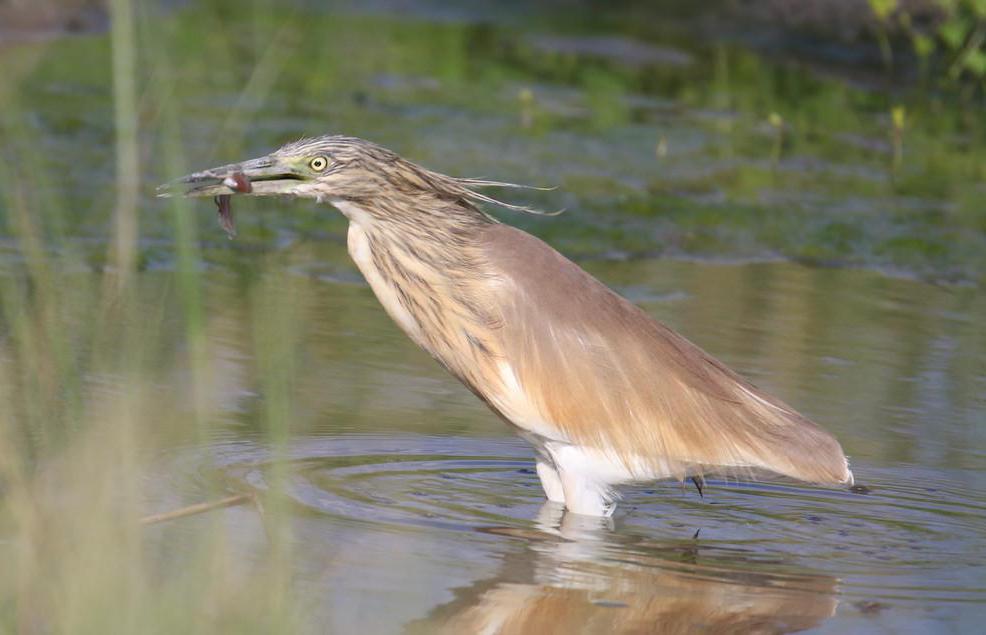At AllThingsNature, we're committed to delivering accurate, trustworthy information. Our expert-authored content is rigorously fact-checked and sourced from credible authorities. Discover how we uphold the highest standards in providing you with reliable knowledge.
What is an American Bittern?
An American bittern is a type of heron. These birds can usually be identified by the brown and white vertical stripes going down the length of their necks and bodies. American bitterns also often have very short legs and distinctively thick bills. This type of bird may grow to a length of 35 inches (89 cm), with a wingspan of up to 50 inches (1.3 m). American bitterns are fairly lightweight birds, not usually exceeding 1 pound (0.5 kg) in weight.
The American bittern is native to North America and is considered a migratory bird. They tend to hover around the United States and Canada during the warm weather and usually head south toward the Caribbean when cold weather hits. In the wild, the American bittern is often spotted around marshy areas. They tend to prefer hiding behind large stalks of grass or reeds instead of being seen out in the open. The vertical stripes on the neck and body help the American bittern to blend in with tall grass.

In general, most American bitterns will eat whatever type of food they can find. They tend to eat a lot of fish and amphibians because of their tendency to live in marshy areas. It is also not uncommon to see an American bittern eating insects or small mammals such as mice or moles. These birds tend to be accomplished hunters, and their sharp, pointed bill may help them with effectively catching prey.

Most of these birds build their nests on the ground rather than up inside tree cavities. The male and female birds typically have a monogamous relationship, and the male normally helps to defend the nest built by the female during incubation. Unlike many other types of birds, male American bitterns do not help help the female take care of the young birds. Incubation lasts for roughly three weeks. The young usually do not leave the nest for good until they are at least a few months old.
American bitterns normally live up to eight years in the wild. As of 2010, these birds are not an endangered species. Even though they are not spotted frequently, this is probably more a result of the secretive nature of the American bittern rather than a diminishing population. The number of wetlands in North America are gradually decreasing, and this may pose a threat to their numbers at some point in the future.
Frequently Asked Questions
What is an American Bittern?
The American Bittern (Botaurus lentiginosus) is a wading bird belonging to the heron family. It is known for its elusive behavior, often hiding in reeds and marshes across North America. With a streaked brown appearance, it blends seamlessly into its wetland habitats, making it a master of camouflage. Its distinctive "booming" call is a hallmark of its presence.
Where can you find American Bitterns?
American Bitterns are found throughout North America, with their range extending from Canada to northern Mexico. They favor freshwater marshes, wet meadows, and reed beds. During the breeding season, they are more commonly found in the northern parts of their range, while in winter, they migrate to the southern United States and Central America.
What do American Bitterns eat?
American Bitterns have a varied diet that includes fish, amphibians, insects, crustaceans, and small mammals. They hunt by standing still or walking slowly, using their sharp beak to snatch prey. Their hunting technique is patient and stealthy, relying on their cryptic plumage to ambush unsuspecting prey.
How do American Bitterns communicate?
American Bitterns are known for their unique vocalizations, especially the male's deep, resonant "booming" call, which can be heard up to half a mile away. This call is used during the breeding season to establish territory and attract mates. They also use a variety of other sounds for communication, including clucks and hisses.
Are American Bitterns endangered?
While not currently listed as endangered, American Bitterns are considered a species of conservation concern due to habitat loss and degradation. According to the North American Breeding Bird Survey, their populations have experienced a slight decline over the past few decades. Conservation efforts focus on preserving and restoring wetland habitats.
How do American Bitterns raise their young?
American Bitterns are solitary nesters, with females building nests in dense marsh vegetation. They typically lay 2-7 eggs, which the female incubates for about 24-29 days. The chicks are precocial, meaning they are relatively mature and mobile at hatching. The mother cares for them until they fledge at 6-7 weeks old.
AS FEATURED ON:
AS FEATURED ON:












Discuss this Article
Post your comments